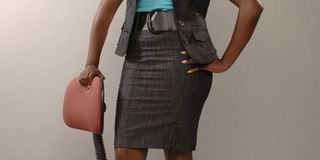Kenyan men prefer women in skirts

PHOTO | FILE An Ipsos Synovate study has revealed that the majority of men prefer women who wear dresses and skirts.
What you need to know:
- Majority say women look more presentable in dresses while weaves and dreadlocks are least favoured, shows a new study
What do Kenyan men like to see women wearing?
According to findings of a new survey released on Wednesday, the majority of men prefer that women wear dresses and skirts.
The Ipsos Synovate study indicates 59 in every 100 men would like to see women wear dresses or skirts as opposed to trousers.
Only 16 per cent of the men prefer to have women wear trousers.
But a quarter of all the men sampled in the study said they did not care what women wore — trouser or skirt.
The preference for trousers is common among men of all age groups.
The study shows 49 per cent of Kenyan men believe women in dresses are more presentable and decent. Others felt such women portrayed respect while some said dresses brought out the better shape for women.
“They (dresses) make them look decent,” said the majority of the men.
Men who said they like women in trousers argued the garments not only made the women look presentable, but also made them look confident and classy.
However, men who are above 41 years were more undecided. “A skirt, a dress, a trouser. Either of them is fine for me,” the survey says.
On hairstyles, the majority of men, 40 per cent, said they preferred long hair.
Weaves and dreadlocks are not popular with most Kenyan men, according to the survey conducted last month. Dreadlocks are the least preferred, attracting a vote of only six in every 100 men.
“Women purchase more shirts and trousers, than dresses and even skirts,” the survey shows. “Skirts are the least purchased.”
At the same time, the survey indicates that men spend as much on shopping as women do.
The pollsters found out that women spend an average of Sh500 on a shirt while men spend Sh900.
The maximum the women spent on a shirt was Sh2,000 while men spent as much as Sh10,000.
A majority of the people surveyed said the average they spent on clothes was between Sh1,000 and Sh5,000.
Only two per cent of the respondents said they had spent more than Sh10,000.
A majority of those surveyed said they purchase their clothes in stalls (exhibitions) and in second-hand markets. Only a small number said they purchased clothes in boutiques and from abroad.
The survey found out that clothes designed locally are unpopular.
Some of the reasons given for this included, “I don’t like their designs; the designs are common, and not attractive.”
The study shows that urban men shop for clothes as often as women do. And they spend much more, too.
Ipsos Synovate conducted the fashion and lifestyle poll in Nairobi, Mombasa and Kisumu.
The pollster partnered with Kiko Romeo and Fafa (Festival of African Fashion and Arts) in collecting the data.
Ms Anne McCreath, the managing director of Kiko Romeo, welcomed the survey’s findings.
“I am very excited that this data has been collected and hope that it is just the start of many more relevant surveys in the future,” Ms McCreath said.
She added: “A few surveys have shown some numbers on mitumba clothes versus new ones but there is no reliable information on designer fashion, exhibitions, tailors and comparative data.
“We need to understand how the market thinks and shops, so that designers and local clothing brands can better understand where to put their efforts for maximum returns.”




